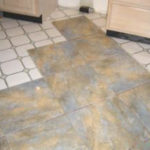[et_pb_section fb_built=”1″ admin_label=”section” _builder_version=”3.0.47″][et_pb_row admin_label=”row” _builder_version=”3.0.48″ background_size=”initial” background_position=”top_left” background_repeat=”repeat”][et_pb_column type=”4_4″ _builder_version=”3.0.47″ parallax=”off” parallax_method=”on”][et_pb_text _builder_version=”3.18.2″ background_size=”initial” background_position=”top_left” background_repeat=”repeat”]

High-quality tile can be installed over an existing floor when the preparation has been done correctly.
Your flooring options needn’t have a high cost, or require hours of intensive demolition. If a room is basically square, level and has a solid floor, installing floor tiles over the existing floor is a way to go. The quality of the existing floor and the material you want to replace makes a big difference. Not all floors are up to it. Some times is best to get a new vinyl tile installation if your floor is to damage.
Consider what it takes to put quality tile over an existing floor. First, what are you trying to replace? Your flooring options can be dictated by the existing substrate. Vinyl and existing tile floors are the most likely candidates, we are huge fans of vinyl plank flooring.
Critical Elements In All Flooring Options
No matter if you’re putting your new tiles over an existing vinyl or existing tile floor there are elements of the project that must be taken into account. In this case, planning really pays.
Height— The Tile Council of North America (TCNA) recommends a wood substrate floor that’s at least 1 1/8- inches thick. Add your tile on top of that and your new floor can be as much as ½-inch higher than the old one. That doesn’t seem like a lot, but it could require retooling doors, cabinets or appliances – and remember, a metal entry door can’t just be easily trimmed at the bottom. Or, if the new tile is to blend with an existing floor – hardwood for example – a ½-inch difference can become a tripping hazard. Hundreds of flooring projects have come down to an “Oh, no!” moment because the new height wasn’t factored in.
To insure a smooth, level surface, a new layer of backer board over the top and screwed directly to the subfloor works well. Or, there are new crack isolation membranes that will do the same thing. And, these membranes are thinner than the board so they reduce the overall height of the new floor.
Floor Tiles Over Vinyl
If the original floor contractor installed the floor properly, it can be a long, tedious chore to remove it. Considering flooring options that don’t require removing the old floor saves time, stress and money. If the existing vinyl floor was glued directly to a concrete subfloor, putting new tile floor over the top shouldn’t be a problem – unless the concrete is cracked or uneven. This kind of installation will likely be found in a basement remodel in the Madison WI area.
The common installation in a modern home on the first or second floor is vinyl applied to a wooden subfloor. The most important issue when laying a new tile floor over this kind of installation is making sure the surface is level and does not move – subflooring isn’t always snug to floor joists. If you hear creaking when you walk on the floor, the subfloor is likely moving. This kind of movement, over time, can cause new floor tiles to shift and crack. The subsurface must be hard – no spongy linoleum.
Floor Tiles Over Existing Tiles
The same considerations apply to laying a new tile floor over an existing tile floor. The surface must be solid and level. Loose tiles can be extracted and the gaps filled with a floor leveling compound. CAUTION: If there are too many loose tiles, the new floor will be weak and you may have to remove the old floor before installing the new one.
Rules Of Thumb For All Flooring Options
- Don’t try to hide mistakes or flaws under a new floor – they can come back to haunt you. Cracking, peeling vinyl or chipped, loose tile has to be dealt with upfront.
- The new floor will be thicker/taller – plan for it.
- Consider every transition from the new floor to other existing surfaces – room-to-room, doors both interior and exterior.
Today’s new tiles offer durable, high-end flooring options and in many cases installing new tile over an existing surface is a viable solution. A new floor over an old one can save hours of work and hundreds of dollars but not every existing floor is up to the challenge. To help determine your best flooring options, contact Molony Tile, a source for unique, durable and elegant tile solutions in Madison WI and greater Dane county including Middleton, Waunakee, Verona, Fitchburg, McFarland, Oregon, Stoughton, Cottage Grove and Sun Prairie. Call or email Molony Tile, 608-268-8453 for professional products, sound advice and a selection of floor tiles to enable all your flooring options in Madison WI.
[/et_pb_text][/et_pb_column][/et_pb_row][/et_pb_section]

